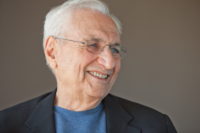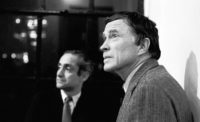Paul Goldberger Reflects on Vincent Scully’s Legacy

Scully chats with students in the Yale Law School auditorium.
Photo courtesy Department of Manuscripts and Archives, Yale University
You could say of Vincent Scully, as Philip Johnson did, that he was “the most influential architecture teacher ever” but that would only begin to explain the architectural historian who taught at Yale for the better part of six decades; gave the Shingle Style its name; wrote several of the most important books of the late twentieth century on subjects as wide-ranging as Greek temples, Native American pueblos, and American urbanism; gave impassioned lectures that packed Yale auditoriums; campaigned against the failings of New Haven’s urban renewal; effectively launched the career of Louis Kahn and, later, that of Robert Venturi; served as a kind of philosopher-king to the New Urbanism movement; gave the Jefferson Lecture in the Humanities in 1995, had a prize at the National Building Museum named for him in 1999 and won the National Medal of the Arts in 2004; and was mentor to Robert A.M. Stern, David Childs, David McCullough, Andres Duany, Elizabeth Plater-Zyberk, Maya Lin and countless other architects, scholars and writers, including, I would humbly add, myself.

Scully, who died at 97 at his home in Lynchburg, Virginia, on November 30, wasn’t technically an architecture teacher at all, since he didn’t teach students in the Yale School of Architecture how to design buildings. He spent his career in Yale’s art history department, where he taught students how to appreciate them. That was the key to his vast sphere of influence: he didn’t speak only to architects, but to everyone. Scully taught more future bankers and lawyers and doctors than future architects, and he probably made more of them into good clients, or at least into lovers of architecture, than anyone else who ever lived.
Unlike the celebrity professors of a later generation, Scully did not see teaching as a burden to be fit in between media appearances. It was the heart and soul of what he did, and he almost never missed a class. He came from an age that had no notion of Power Point; he spent hours in Yale’s slide library before every lecture, meticulously choosing the images he would talk about, or talk from. The slides would be projected, in pairs, on a huge screen in the large auditorium that was almost invariably filled for his lectures, which were performances as much as anything else. He would stride into the room just as the lights dimmed, mount the platform, and pick up a huge wooden pointer, which he would bang against the screen in frustration if the slide projectionist mixed anything up. The images were always different, and they were memorable because they were not just of buildings, but of so much else: a Franz Kline painting juxtaposed beside the plan of a city, Venturi’s mother’s house beside McKim, Mead & White’s Low House, the Saint Gaudens memorial in the Boston Common beside not an image but the words of Robert Lowell’s poem, “For the Union Dead.”
That was the essence of Scully: he taught that architecture was not just about shape and form, but about everything in the culture. He had started out as a student of English literature, and he was always able, more than most art historians, to connect the visual to the verbal. His subject was not buildings so much as it was the role buildings played in the making and the preservation of community. If his critical eye had not been so sure, if his grasp of form not so acute, he might have seemed almost too earnest. He had heroes, and villains, and he had a tendency, sometimes, to see things in black and white terms. (He agonized over whether or not to accept the National Medal of the Arts because it was to be conferred upon him by George W. Bush, whose policies he despised.)
He certainly could never be accused of hiding his passions. First there was Frank Lloyd Wright and then there was Louis Kahn, whose work he championed early—he helped persuade Yale’s president in the early 1950’s, Whitney Griswold, to hire the little-known Kahn to design the 1953 extension to the Yale Art Gallery, and later wrote the first book about Kahn. And then there was Robert Venturi, whose Complexity and Contradiction in Architecture Scully helped publish, and which he called in his introduction “the most important work on architecture since Le Corbusier’s Vers Une Architecture.”
Scully started his career as an unabashed celebrator of the most heroic ambitions of modernism, which he came, gradually, to question. Not the least of his gifts as a teacher was his ability to admit to both his students and his readers that he might not have been right, and that he had changed his mind. Ultimately he would come to think of urbanism as equally important to form-making, and to cherish older buildings so much that he became an ardent preservationist. He expressed regret for failing to speak out against the demolition of McKim’s Pennsylvania Station, saying, in what became one of his most famous lines, “One entered the city like a god. Now you scuttle in underground, like a rat.”
In 1969, Scully wrote, in a far less quoted line, that art history had to be “conservative, experimental, and ethical.” It was a remarkable trio of words, not least because of the apparent contradictions it embraced. Scully knew that art history had to respect the past, since learning from the great work of history is central to its mission; at the same time, he wanted to make the point that the real value of understanding the architecture of the past is to inspire the highest creativity in the present. And he believed that the noblest mission of architectural history, at least as he practiced it, was to encourage the building of community, and the betterment of civilization.
Watch a trailer for the 2010 documentary on Vincent Scully by Checkerboard Films.



